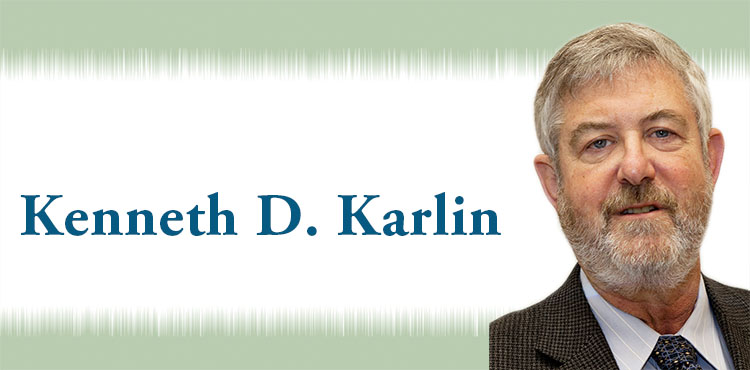
Kenneth D. Karlin
Ira Remsen Chair in Chemistry, Department of Chemistry, John Hopkins University, USA
Primary Copper-Dioxygen Adducts; Copper Enzymes and Synthetic Bioinorganic Chemistry
Copper ion is a vital constituent of metalloprotein active sites necessary to support life. Cu-protein roles include electron shuttling, and the processing of small molecule nitrogen oxides or molecular oxygen (dioxygen; O2). Copper proteins participate in O2-transport, oxygenase activity (i.e., O-atom insertion) and O2-reduction to H2O2 or water. Functions include pigment production, activation/production of neurotransmitters-hormones and the scavenging of reactive oxygen species. The biochemistry of copper surrounds its rich one-electron (e−) CuII/CuI redox chemistry. An overview of relevant protein chemistry will be woven into the presentation. Copper(II)-superoxide complexes derive from the reaction of dioxygen with copper(I) compounds; they are primary Cu-O2 adducts. Their structures, physical-spectroscopic and reactivity properties are of fundamental interest, as concerns their biochemistry and potential impact on practical applications. Our program on copper-dioxygen chemistry focuses on ligand design and their systematic variation as well as the use of cryogenic solution handling for the investigation of new Cun/O2 species. The rationale behind this 'modeling' approach will be mentioned. Our efforts in copper(II)-superoxide chemistry will be presented. Thus, the generation, characterization and study of reactivity (and mechanism) will focus on (ligand)CuII-superoxo complexes of differing identity. Reaction chemistry to be described will include the interaction of Cu-O2 species with C–H and O–H bond containing substrates, or reduction-protonation employing redox reagents and protic acids. The effect of replacing a ligand N-donor atom with a thioether group, or providing for a hydrogen-bonding group in proximity to the bound superoxide ligand, will be described and possible biochemical relevance discussed.Kenneth (Ken) Karlin earned his Ph.D. at Columbia University, New York in 1975 and did postdoctoral studies at Cambridge University, England, before joining the chemistry faculty at the State University of New York (SUNY) at Albany in 1977. He moved to Johns Hopkins University in 1990 where he holds the Ira Remsen Chair in Chemistry.
Karlin's research focuses on coordination chemistry relevant to biological and environmental processes, involving copper or heme complexes. His work has emphasized the reactivity of copper and heme-Cu(Fe) systems with dioxygen (O2), nitrogen oxides (NOx), and metal/O2 chemistries with organic substrates. Prior studies included metal ion interactions and redox chemistry with organohalide pollutants, DNA and peptides. The long term goal is to provide a sound basis for deducing biological active site structures, the nature of reactive intermediates, and a rationale for the design of practical O2-carriers, organic oxidation reagents and NOx reduction catalysts. His group has also studied copper peptide complexes using amino acids and peptide sequences that are relevant to copper protein active sites, and/or those suggested to effect biological oxidative damage in Alzheimer’s disease.
For his numerous contributions, Karlin has received various recognitions: Maryland Chemist of the Year Award (American Chemical Society Maryland Section) (2011); F. Albert Cotton Award in Synthetic Inorganic Chemistry (2009), an American Chemical Society (ACS) National Award; ACS Sierra Nevada Distinguished Chemist Award (2009); JSPS Fellowship; Distinguished Visitors Lecturer, Haverford College (2005); "MERIT" Award, National Institute of General Medical Sciences (NIH) (1993-2003); Karcher Lecturer, Univ. Oklahoma (1993); and the Buck-Whitney Award (ACS Eastern New York Section Research Award) (1991). He was just elected as a Fellow of the American Chemical Society (ACS) (2014) and previously chosen as a Fellow of the American Association for the Advancement of Science (AAAS) (1992).

